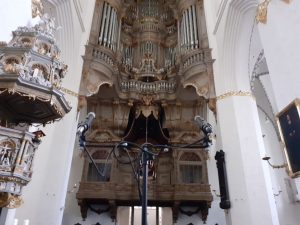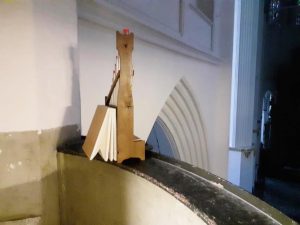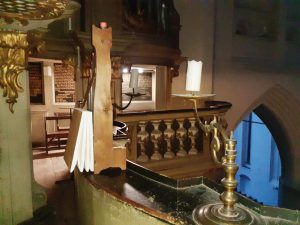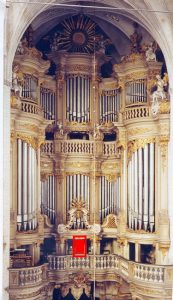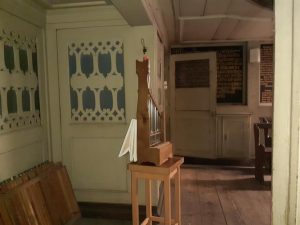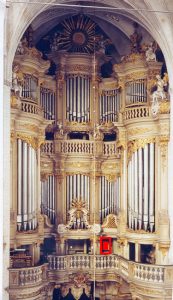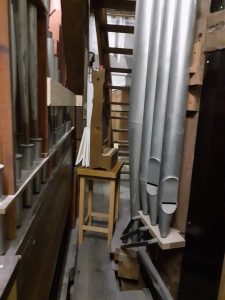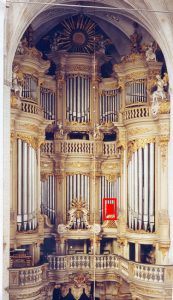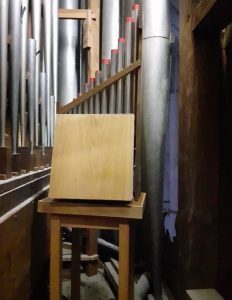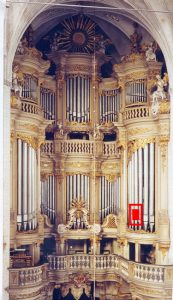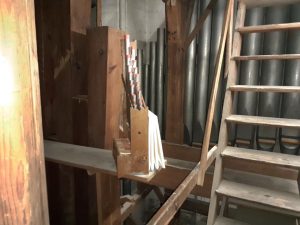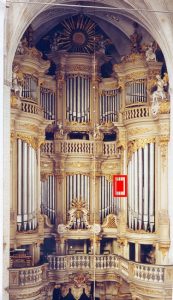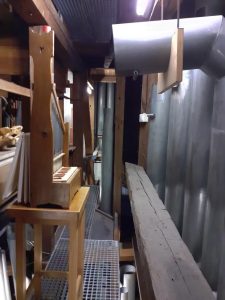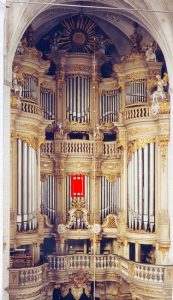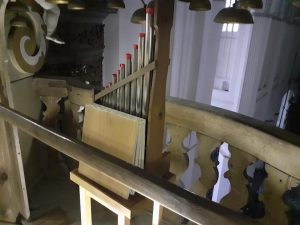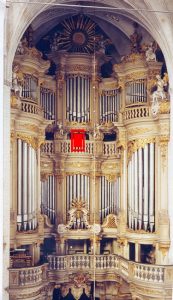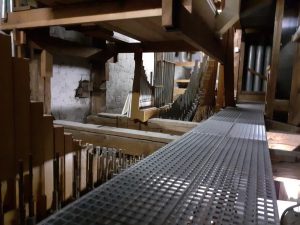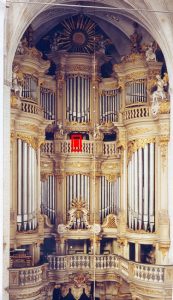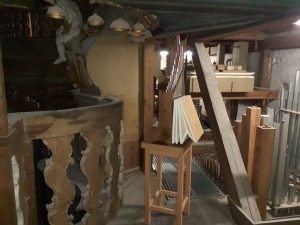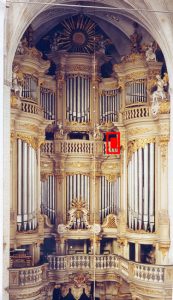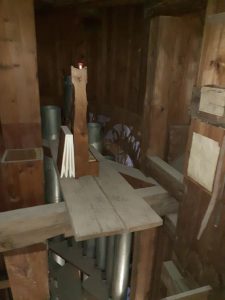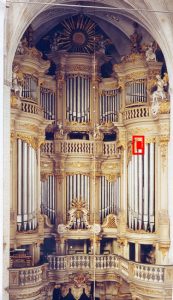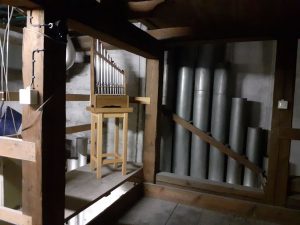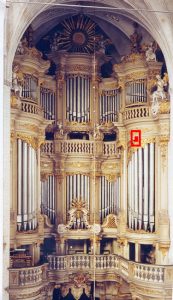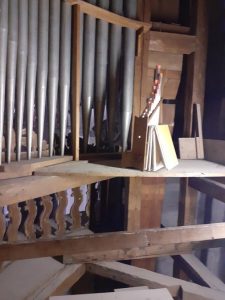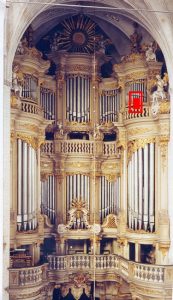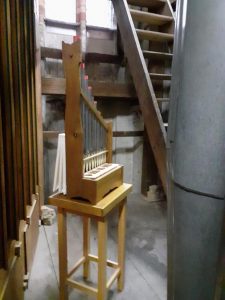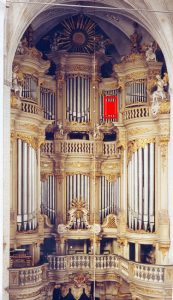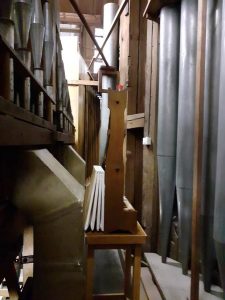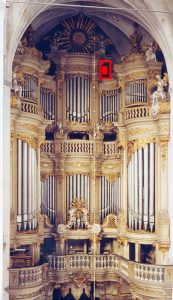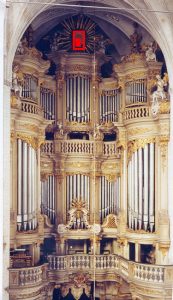Acoustic Research of Organ Situation
In print, as well as online, an evaluation of the outcome by Karl-Bernhardin Kropf is missing. As ist touches the current work of the advisory board, it will be published later.
Acoustic Research of the Situation of Organ Loft and Organ Case of St. Mary’s Rostock, October 2020
Karl-Bernhardin Kropf
Baseline:
During the preparation of the organ’s restoration, collecting data and information regarding pipework’s positions within the organ case seemed necessay. There were preconceptions to be judged. Organ builders use portable voicing chests for this. Lacking such a device, a small portative organ (“organetto”) has been used. On this, a section of a scale with o following chord was played. This part should illustrate building up the volume from direct sound and reverberation. Afterwards, fast repetions were played with a high pitched pipe and modulated wind pressure, so that during exhaling partial notes became audible. This part was used to check the positions suitability for pipes being playable even on widely reduced wind.

The portative (a = ca. 415 Hz) was tuned in a way to produce a pure C-major triad (sounding pitch B). By this, the correct wind pressure can be observed – if pure, the pressure is correct. As the recordings proof, it was possible to maintain widely equal pressure for comparable results throughout the recordings.
Recording took place in the church’s crossing. Two micophones (AKG C-1000, cardiod) were mounted in A/B-pattern on ear level of a standing person. Via an interface (ZOOM TAC-02) signal was recorded in 44,1 kHz/24bit format. The whole audio file, spanning more than an hour, was overall levelled up. Under editing of the different position clips, no more level modification took place, of course. As level relations wre in the focus, the equipment seemed to be sufficient. For a state-of-the-art audio recording (to capture most details etc.), an even more sophisticated equipment could be imagined. The recordings have been archived in WAV-format. For online distribution, a high-qualitiy mp3 data compression of 320 kb/s was used.
Positions
Mostly, positions where pipework already is located have been chosen for recording the portative sounds. Some positions are not occupied by pipework yet, and moreover, two recordings have been made with the portative placed on the balcony of the organ loft (at center and at the northern jutty, often referred as “Halleluja Rock”).
Problems
In 2020, a lengthy restoration project at the windows of the north-eastern aisle is under way. Road noise, even quite audible in church at normal conditions, is even louder now due to the substituting paperboard and plastic sheet. Occasionally, the first part of a positions’ recording (the triad) had to be split from the second, when a car or a tram caused a noise peak.
Because of the often complicated placement of the portative, the player’s position became tricky. This lead to some occasional “dirt”. I also tried to avoid shading the instrument’s sound emission with my body. Therefore, the northern half of the organ was chosen, placing me standing, sitting or lying at the left end of the portative and having turned the right end towards the room. Only at two positions it was necessary to flip to the southern half of the organ, as local circumstances (stairs, catwalks etc.) were more favorable there.
Sort of “calibration” has been recorded, too. The lowest portative pipe was placed into Kronwerk division. Though some side-air occured at the pipe’s foot, the sound could be sued to be compared with the respective pipes oc the Octav 4′ stops of the other divisions. After the portative pipe, the pipes of Manuals IV, III, I and II are being heard. Of course, the portative pipe is the weakest, but the tonal relations to the “real” stops is audible. As sort of a permanent calibration, the ticking of the Astronomical Clock (from 1473, placed at the back of the high altar) may serve. It has been well picked-up in spite of the mic’s preference of sounds coming from western direction, due to the high level of sensitivity of the whole setup.
Sequence of recordings
The recordings were made by a sort of wandering through the positions and have been sorted a first time in sort of geographical order. In the following image, the envelopes (i. e. level diagrams) of the recordings are shown with their numbers. It is followed by an explaining list of the positions. Behind each entry there are two numers, e. g. 24/13. These are the level values, rounded by 0,5, on the two level scales (digital/RMS)in DeziBel, as provided by the recording software (Cubase 9).
The absolute values are not so meaningful, as they change by gain adjustment etc. But overall levelling is identical for all clips of the recording, so that their relative volume can be read. As for volume, a non-linear scale with a peak of 0 db (full level) is being used – the higher the number, the lower the audible volume is. Minimum differences in the aural perception and in the measurement are due to psycho-acoustic effects, but also due to the influence of environmental noise, even if the ear is masking it.
Maximum level of the loudest clip (also Nr 01) has been drawn-through as a line.
01 organ loft balustrade, front jutty 17/6.5
02 organ loft balustrade, center 17/8
03 organ loft, back corner 24/13
04 tuning walk between Man. II soundbourds (level 1) 27.5/16.5
05 behind facade pipes, corner field 22/12
06 between stairs and old Kleinpedal chest 26/15
07 pedal tower on chest level (level 1) 23/10
08 Corner facade field on level of new Kleinpedal chest (level 2) 26.5/16
09 behind Principal 16′ pipes, center facade field 24.5/14.5
10 center of middle balcony (level 3) 20/9
11 tuning walk between chests of Man. I 26/15.5
12 corner field of middle balcony 24/13
13 upper walk at Pedal 22/10.5
14 level 3 back corner (swell tremulants) 26/15
15 pedal tower, upper facade (level 4) 21.5/11.5
16 corner field of upper facade pipes 24.5/14.5
17 center field of upper facade pipes 24/14
18 roof of swell division (level 5) 23/13
19 small platform between Kronwerk and swell 22/11
20 Kronwerk 23.5/13.5
The “calibration” recording with the comparison of prtative volume with extant pipe material of the organ is here:
Listen to the pipes of c‘ portative resp. b from Octav 4‘ in the order portative, Manual IV, Manual III, Manual I, Manual II
Here follow the individual presentations, followed by comparisons.
Please note: Certainly for the comparing audio clips, a good sound reproduction is desirable. On small loudspeakers, the quite small differences of dynamics may not be distinguished.
The individual recordings – position details and audio clips
03 organ loft, back corner, on the line of the historic panels (before 1938), a hypothetical location for a “Unterwerk” division
08 Corner facade field on level of new Kleinpedal chest and Pedal Principal 16′ (level 2), southern side
Comparisons
For a direct sequence of sounds and to illustrate the notable decrease of power and presence in space, the maximum of every recording was cut out for the length of one second and put into descending order. Thus one gets from the strongest to the weakest position within 20 seconds. Here follows the order in respect of envelope/dynamic:

The order as a list:
01 organ loft balustrade, front jutty 17/6.5
02 organ loft balustrade, center 17/8
10 center of middle balcony (level 3) 20/9
15 pedal tower, upper facade (level 4) 21.5/11.5
19 small platform between Kronwerk and swell 22/11
13 upper walk at Pedal 22/10.5
05 behind facade pipes, corner field 22/12
18 roof of swell division (level 5) 23/13
07 pedal tower on chest level (level 1) 23/10
20 Kronwerk 23.5/13.5
03 organ loft, back corner 24/13
17 center field of upper facade pipes 24/14
12 corner field of middle balcony 24/13
16 corner field of upper facade pipes 24.5/14.5
09 behind Principal 16′ pipes, center facade field 24.5/14.5
06 between stairs and old Kleinpedal chest 26/15
14 level 3 back corner (swell tremulants) 26/15
11 tuning walk between chests of Man. I 26/15.5
08 Corner facade field on level of new Kleinpedal chest (level 2) 26.5/16
04 tuning walk between Man. II soundbourds (level 1) 27.5/16.5
First, an audio-only version:
Sequence of sounds in order of the above list:
Two comparing couples have been arranged, first the combination of strongest and weakest sound at all:
01 organ loft balustrade, front jutty, followed by 04 tuning walk between Man. II soundbourds (level 1)
…and second, the strongest and weakest sound coming from a position within the organ case:
10 – center of middle balcony (level 3), followed by 04 – 04 tuning walk between Man. II soundbourds (level 1)
There is also a video clip illustrating these three recordings, showing the facade and synchronously changing marks of positions. The size of the red frame and the inner rectangle illustrate the porative’s position being more on the front or in the back of the organ case. The positions recorded in the southern half of the organ case have been shown on their respective northern places:


